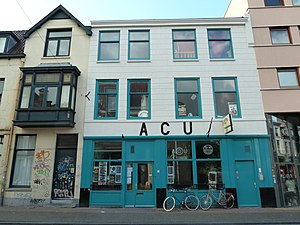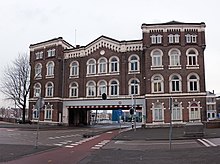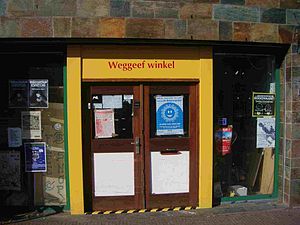
Squatting is the action of occupying an abandoned or unoccupied area of land or a building, usually residential, that the squatter does not own, rent or otherwise have lawful permission to use. The United Nations estimated in 2003 that there were one billion slum residents and squatters globally. Squatting occurs worldwide and tends to occur when people who are poor and homeless find empty buildings or land to occupy for housing. It has a long history, broken down by country below.

The Poortgebouw is a national monument located at Stieltjesstraat 38 in the Kop van Zuid area of Rotterdam, the Netherlands. It was built beside the River Maas in 1879 and experienced a range of uses until it was squatted 3 October 1980. It had been standing empty for 2 years and was squatted as a protest intended to highlight the lack of affordable residential housing in Rotterdam.
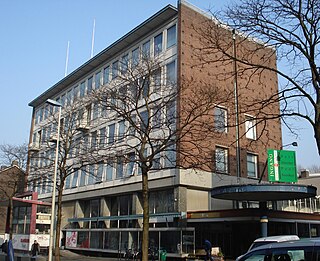
Het Slaakhuis, or Slaakhuys, is a monumental building in Rotterdam, the Netherlands. It was the former offices of the socialist newspaper Het Vrije Volk. The building is a six-storey office block located on a street called Slaak and was squatted in May 2003. The snooker centre next door, which hosted greats such as Ronnie O'Sullivan was also later squatted. In 2011, the complex was evicted and by 2017 it had become a hotel and a Lidl supermarket.
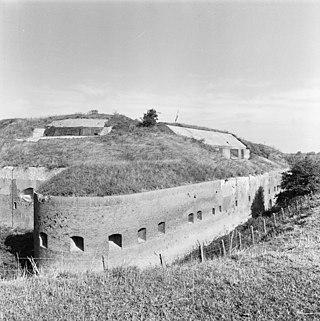
Fort Pannerden is a disused military fort situated near the village of Pannerden in the southeast of the Netherlands. In November 2006, it became the focus of national news stories because a group of squatters were evicted in a large-scale operation by police, helped by the army. Later on in the same month, it was resquatted.
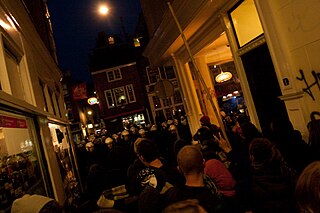
The Dutch squatting ban refers to the law introduced on 1 October 2010, under which squatting in the Netherlands became de jure illegal. Criminalization had first been proposed in the 1970s, but was opposed by the Council of Churches. In 2006, a new plan was proposed and backed by parties including VVD and PVV. When the new law was introduced, squatters occupied the former head office of the fire brigade and there were riots in Amsterdam and Nijmegen. In 2011, the Supreme Court of the Netherlands ruled that the legally forced end of squatting can only occur after an intervention of a judge. Between October 2010 and December 2014, 529 people were arrested for the act of occupying derelict buildings, in 213 separate incidents as a result of which 39 people were jailed.
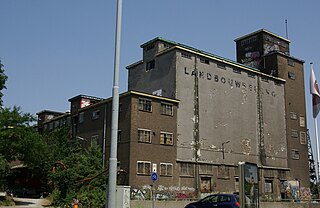
Landbouwbelang (LBB) is a squatted industrial building in Maastricht, Netherlands. It offers working space for artists and social entrepreneurs and functions as a venue for cultural events. It has been squatted since April 2002.
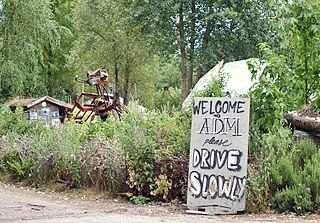
ADM was a squat in the Port of Amsterdam, to the west of the city next to the North Sea Canal. The squat lasted from 1997 until its eviction in early 2019. Around 130 people lived on the terrain of 45 hectares in buildings, on boats and in vehicles.

De Grote Broek is a legalised squat and self-managed social centre in central Nijmegen in the Netherlands. It was occupied in 1984 and legalised from 2002 onwards. It spans two sides of a city block and has entrances on both Van Broeckhuysenstraat and Tweede Walstraat. The project consists of two separate housing co-operatives living above a cafe on one side and Extrapool and a music venue on the other. Groups with shared political objectives are hosted at the centre.

Vrijplaats Koppenhinksteeg was a complex of buildings first squatted in 1968 in Leiden, the Netherlands. It took its name from the alley on which it was located and was run since the 1990s by the Vrijplaats Koppenhinksteeg Foundation. Various groups including Eurodusnie used the different spaces as a bar, café, a freeshop, a foundation to support undocumented migrants, an information centre, a library and a sports club. In 2010, the entire complex was evicted. From 2012 onwards a new space called the Vrijplaats Leiden was set up elsewhere.

We Are Here is a collective of migrants based in Amsterdam, the Netherlands, which campaigns for human rights for its members and all undocumented migrants. The asylum seekers have in many cases had their applications to remain in the Netherlands denied but they either cannot go back or refuse to return to their country of origin. They demand access to social services such as medical care and housing. The group formed in 2012 and by 2015 contained over 200 migrants from around 15 countries.

Vrankrijk is a legalised squat and self-managed social centre on the Spuistraat in central Amsterdam. There is an events space on the ground floor and above it a separate housing group.
The WNC squat was a self-managed social centre in Groningen, the Netherlands. It was squatted in 1985 and evicted in 1990.
Ecotribe Teuge is a collective of people living on a squatted terrain in the Dutch countryside. It is located on the edge of the village of Teuge, in the province of Gelderland. The buildings were constructed by the Nazis and formerly used to house Moluccan soldiers. The site was occupied in 2001, when people began to live there in an off-the-grid and self-sufficient manner. Since 2018, there are plans by the province to develop the terrain.

The Tabakspanden are a group of buildings standing on the Spuistraat in central Amsterdam, adjacent to the Keizerrijk and Wijdesteeg alleyways. Named after a former owner, the speculator Hendrik Tabak, they were mostly squatted from 1983 onwards, although the artist Peter Klashorst also rented an apartment and gallery space. The best known building was Spuistraat 199, known as the Slangenpand (Snakehouse) because of the large mural which covered the front exterior. In 2015, the squatters were evicted and the buildings were mostly demolished prior to redevelopment. The new project is known as De Keizer and has 69 apartments, a restaurant and a gallery. Two of the buildings are registered as rijksmonumenten.

De Vloek was a squatted, self-managed social centre in The Hague, the Netherlands, between 2002 and 2015. Located on Hellingweg 127 in Scheveningen, beside the North Sea, the squat hosted workplaces, living spaces, a venue, and a vegan restaurant. The local council tolerated the occupation until 2014, when it decided to sell the building. A political struggle over the eviction began; some political parties supported the squatters and the Scheveningen Pier was briefly occupied as a protest action. A deal was made for the squatters to move to a former school building and the Vloek was eventually evicted in September 2015.

The Ubica buildings are two adjacent buildings standing at 24 and 26 Ganzenmarkt, in central Utrecht, the Netherlands. Number 24 is a rijksmonument. The first recorded mention of the buildings is from 1319. After centuries of residential use, the buildings were bought by the Ubica mattress company in 1913 and used until a devastating fire in 1989. The buildings were then squatted for 21 years, before being redeveloped into a hotel and café-restaurant in 2014.
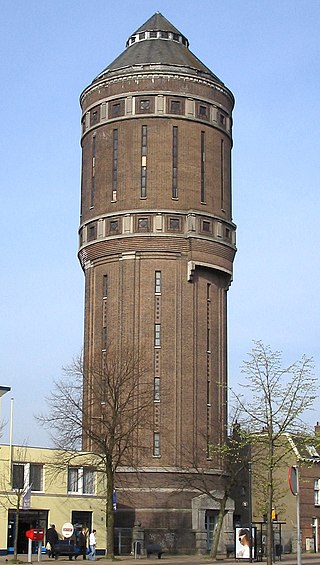
The Amsterdamsestraatweg Water Tower is located in Utrecht, the Netherlands. The water tower was built at Amsterdamsestraatweg 380 in 1916, in the style of the Amsterdam School. It became derelict in 1986 and was repeatedly squatted before its redevelopment into apartments began in 2020.
Vossiusstraat 16 is a squatted building in central Amsterdam, the Netherlands. It is owned by the Russian billionaire Arkady Volozh, co-founder of Yandex Search and formerly head of Yandex, who has been sanctioned as part of international reactions to the Russo-Ukrainian War. It was occupied in October 2022 to protest both Volozh's ownership and the housing crisis in Amsterdam. Volozh quickly took the squatters to court and lost his claim for possession since he cannot live in the property or enter the Netherlands; he appealed the decision and lost again. The squatters live in the building and have organised events there.

The Wyers squat was a self-managed social centre on Nieuwezijds Voorburgwal in central Amsterdam, the Netherlands, between 1981 and 1984. The buildings of the Wyers former wholesale textile company were converted by the squatters into a range of living and work spaces. When the Government of Amsterdam decided to demolish the complex to make way for a Holiday Inn hotel, a car parking garage and apartments, the squatters made alternative proposals. The eviction was announced for February 14 1984 and there were demonstrations in support of the squat around the country. On the day of eviction, 1,500 people stayed inside the building then left without conflict. The breeding place discourse of new cultural initiatives presented by the squatters was later adopted by the city council.
